Echizen Kiln Site Group:
The history of Echizen ware, a traditional Japanese craft item, becomes more concrete through new discoveries of kiln sites.
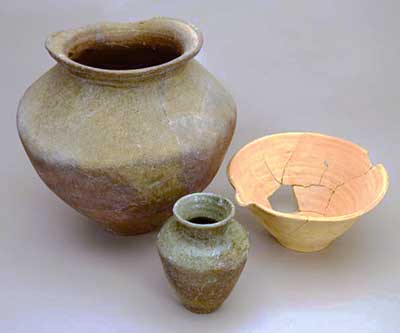
A set of three representative Echizen ware items, a jar, vase, and grinding bowl. From the left: jar inscribed with the “Iroha” poem (rim diameter 35.4 cm, vessel height 47.2 cm); vase (rim diameter 12 cm, vessel height 24.1 cm); grinding bowl (rim diameter 34.6 cm, vessel height 17.8 cm). All three vessel types were indispensable in the daily lives of common people. |
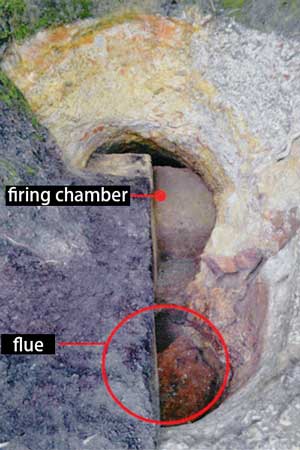
Middle Muromachi period kiln as unearthed (Kamayadani kiln site) The firing chamber is 2.5 m in width, and its floor is at a steep angle of 40 degrees. The greatest width of the flue for exhausting the smoke is 2 m, and the side walls had turned reddish brown from the heat. Adapted from Hakkutsu sareta Nihon rettō 2015 [Excavations in the Japanese Archipelago, 2015] (Bunkachō [Agency for Cultural Affairs], ed., Kyodo News, 2015).
|

Diagram of a reconstruction of a renbōshiki (linked chamber) climbing kiln Renbōshiki (linked chamber) climbing kiln as unearthed (Taira Kita kiln site) A kiln with rooms for baking the ware (firing chambers) linked together like cells in a monastery, this is the first time this type has been confirmed for Echizen ware. The furnace door is semi-circular in shape, and there were at least nine chambers. As the width from the fourth chamber on was approximately 5 m, with a depth of about 2 m, it is seen that the kiln increased in width towards the back. |

Bun’enchū (Nishiyama No. 2 kiln site) As seen from the firebox side; to the far side of the bun’enchū (smoke-dividing pillar) is a firing chamber. The portion of the kiln to the pillar’s right has collapsed. From the conditions of recovery of artifacts from within the kiln, the collapse is inferred to have happened after the finished products were removed. Adapted from Hakkutsu sareta Nihon rettō 2015 [Excavations in the Japanese Archipelago, 2015] (Bunkachō [Agency for Cultural Affairs], ed., Kyodo News, 2015).
|

Diagram of a reconstruction of an anagama kiln Adapted from Hakkutsu sareta Nihon rettō 2015 [Excavations in the Japanese Archipelago, 2015] (Bunkachō [Agency for Cultural Affairs], ed., Kyodo News, 2015).
|

Map of the distribution of the Echizen kiln site group On hills to the east and west of the Tennōgawa river, over 200 kilns have been found over an area extending approximately 5 km north–south by 4 km east–west (the most recently discovered 25 items are shown in red font). The earliest kilns were built at the end of the Heian period in the Ozowara subgroup in the eastern portion. In the latter half of the Kamakura period the productive base shifted to the west, with manufacture thought to have been conducted in the latter half of the Muromachi period in the Taira subgroup, centered on the Ōkamaya kiln. Adapted from Hakkutsu sareta Nihon rettō 2015 [Excavations in the Japanese Archipelago, 2015] (Bunkachō [Agency for Cultural Affairs], ed., Kyodo News, 2015).
|
Echizen Kiln Site Group,
Echizen Town, Fukui Prefecture
Heian–Edo periods (twelfth–nineteenth centuries)
Pottery spreading over the Japan Sea coastal region
Echizen ware, known as a product of one of the so-called six ancient kilns of Japan along with Seto, Tokoname, Shigarki, Tanba, and Bizen wares, is a prime example of Japanese stoneware. This simple, unglazed, brown colored ware has been made from the end of the Heian period (around the close of the twelfth century) until the present day, with its principal forms being utilitarian items such as jars, vases, and grinding bowls. Beginning with the Special Historic Site, the Ichijōdani Asakura Family Historic Ruins (Fukui prefecture), it was distributed widely over the Japan Sea coastal region. Through a distribution survey of this group of kilns conducted from 2010, in addition to 25 sites being newly discovered, the history of Echizen ware production has gradually become clear.
Advancements in productive technology come to light
Echizen kilns from the start of production up to the Northern and Southern Courts period (late fourteenth century) were the anagama type (consisting of a single chamber with its firebox, dug into a hill slope in tunnel-like fashion) of more than 10 m length, and they are understood to have been operated in units formed of multiple kilns. During this time, at the Kamakura era (thirteenth century) Nishiyama kiln site group, kilns of different sizes were in operation simultaneously, and this is thought to have been for differential use according to the fired products.
Subsequently, kilns became increasing larger in size, and in previous investigations a kiln approximately 24 m in length has been found. Columns made of fire-resistant stone called bun’enchū (literally, “smoke-dividing pillar”) are found in these large-scaled kilns. This was positioned between the firebox, where the fuel burned, and the firing chamber, where the ceramics were baked, and with this pillar the heat was divided evenly to the left and the right, helping to maintain a uniform temperature within the kiln and lessen the uneven firing of the products. As fire-resistant stone has been ascertained in the recent investigation at the Kamayadani kiln site, the trend for the use of large-scale kilns, and the transition to mass production, are thought to have begun in Echizen at least by the mid-Muromachi period (latter half of the fifteenth century).
Also, at the Taira Kita kiln, part of a renbōshiki (linked chamber) climbing kiln has been confirmed. This type of kiln, which began to spread nationwide in the Edo period (seventeenth century), has multiple firing chambers. Until now the timing and other details of its introduction to Echizen have been uncertain, but with the recent investigation it has become clear that it was in operation at the end of the Edo period (mid-nineteenth century), and that the technology used in kilns at Shigaraki was introduced. (Nakagawa Yoshizō, Kimura Kōichirō)
Various distinctive ceramic items discovered at the Echizen kiln site group, a locus of traditional craft production
Taira Kita kiln site
(End of the Edo period, mid-nineteenth century)
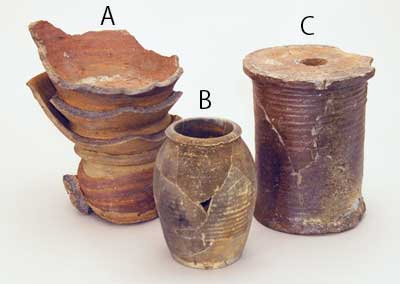
A: Unfinished items from a stacked firing
Surviving height: 33.5 cm. Two grinding bowls are stacked atop a third one, and the base of the jar beneath them became stuck to the kiln.
B: Octopus pot
Rim diameter: 13 cm; vessel height: 23.5 cm.
C: Kiln prop
Rim diameter: 24 cm; vessel height: 30.5 cm. A cylindrical stand on which ceramic items were placed during firing.
Nishiyama kiln site group
(Latter half of the Kamakura period, latter half of the thirteenth century)

Ceramic item in the shape of a human face Surviving length: 9.1 cm; surviving width: 6.1 cm. As the inferred reconstructed size is small, 12–13 cm in length and 10 cm in width, it was possibly a decorative item. The nose and cheek bear finely incised ines |
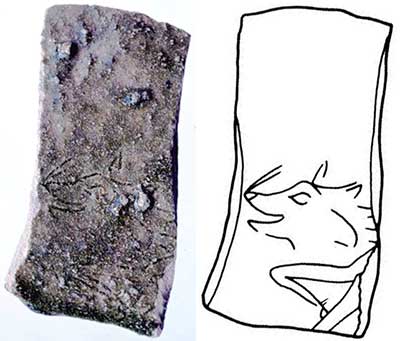
Sherd of a jar with an animal drawing Surviving length: 11.3 cm. This item had the design of an animal (dog? wolf?) drawn with a spatula on the vessel body. Examples of Medieval stoneware with animal drawings are very unusual. |

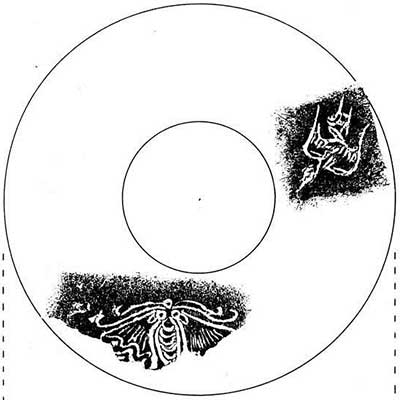
Vase with butterfly and bird drawings Rim diameter 11.3 cm; vessel height: 28.3 cm. Images of a butterfly and a waterfowl taking flight from the water are drawn. | |
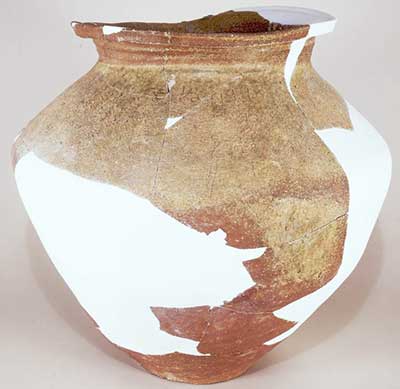

Jar inscribed with the “Iroha” poem Rim diameter 35.4 cm; vessel height: 47.2 cm. Made with the high iron content clay characteristic of Echizen ware, this small jar was built up with the coiling technique. On the upper half of the body is an inscription of the “Iroha” poem. The lettering itself is rather childish and contains errors. | |
